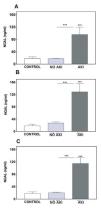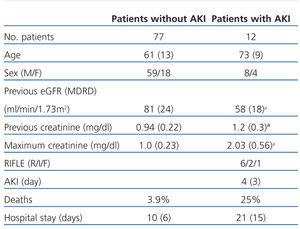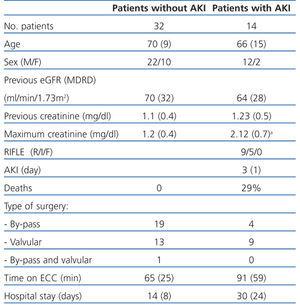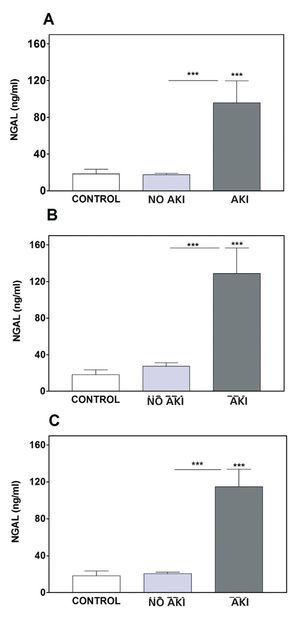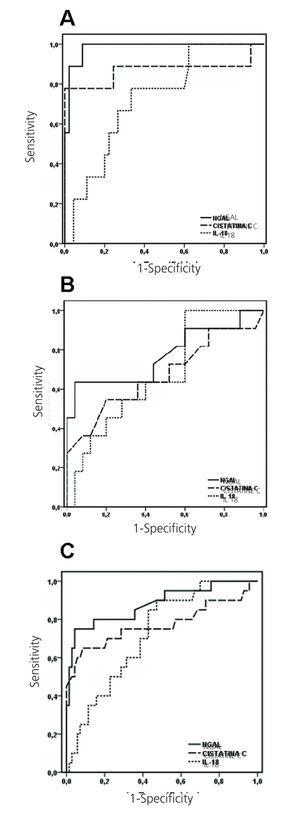Antecedentes: El fracaso renal agudo (FRA) es una complicación frecuente tras la cirugía cardíaca y la angiografía coronaria que ensombrece el pronóstico de estos pacientes. El diagnóstico se basa en el ascenso de la creatinina sérica, que es tardío. Es necesaria la identificación y validación de nuevos biomarcadores precoces que permitan intervenciones más tempranas y eficaces. Objetivos: Evaluar la sensibilidad y especificidad de interleuquina-18 (IL-18) en orina, neutrophil gelatinase-associated lipocalin en orina (uNGAL) y cistatina C en suero para la detección precoz del FRA en una población de pacientes con síndrome coronario agudo o fallo cardíaco y sometidos a cirugía cardíaca o cateterismo. Métodos: Se incluyeron en el estudio 135 pacientes ingresados en una unidad de cuidados intensivos por síndrome coronario agudo o fallo cardíaco por patología coronaria o valvular y a los que se realizaron una angiografía cardíaca o una cirugía cardíaca de revascularización o recambio valvular. Se determinaron los biomarcadores a las 12 horas de la intervención y se monitorizó la creatinina sérica durante los siguientes seis días para el diagnóstico del FRA. Resultados: Para NGAL se obtuvo un área bajo la curva ROC (AUC) de 0,983 y para cistatina C e IL-18 de 0,869 y 0,727, respectivamente. Para un punto de corte de NGAL en orina de 31,9 ng/ml la sensibilidad fue del 100% y la especificidad del 91%. Conclusiones: uNGAL es un marcador precoz de FRA en pacientes con síndrome coronario o fallo cardíaco agudo y sometidos a cirugía cardíaca y angiografía cardíaca, con una capacidad predictiva superior a cistatina o a IL-18.
Background: Acute kidney injury (AKI) is a common complication in cardiac surgery and coronary angiography, which worsens patients’ prognosis. The diagnosis is based on the increase in serum creatinine, which is delayed. It is necessary to identify and validate new biomarkers that allow for early and effective interventions. Aims: To assess the sensitivity and specificity of neutrophil gelatinase-associated lipocalin in urine (uNGAL), interleukin-18 (IL-18) in urine and cystatin C in serum for the early detection of AKI in patients with acute coronary syndrome or heart failure, and who underwent cardiac surgery or catheterization. Methods: The study included 135 patients admitted to the intensive care unit for acute coronary syndrome or heart failure due to coronary or valvular pathology and who underwent coronary angiography or cardiac bypass surgery or valvular replacement. The biomarkers were determined 12 hours after surgery and serum creatinine was monitored during the next six days for the diagnosis of AKI. Results: The area under the ROC curve (AUC) for NGAL was 0.983, and for cystatin C and IL-18 the AUCs were 0.869 and 0.727, respectively. At a cut-off of 31.9ng/ml for uNGAL the sensitivity was 100% and the specificity was 91%. Conclusions: uNGAL is an early marker of AKI in patients with acute coronary syndrome or heart failure and undergoing cardiac surgery and coronary angiography, with a higher predictive value than cystatin C or IL-18.
Introduction
Acute kidney injury (AKI) is a common complication following cardiovascular surgery, with varying incidence rates evidenced in the medical literature that depend both on the definition of AKI used and the population studied, but most estimates are close to 30%.1-3 AKI prolongs the duration of hospital stays and increases the risk of mortality by three to nine times, depending on its severity.2,3 Even small increases in creatinine levels worsen the situation for these patients.4 The mechanisms that contribute to kidney injury include exogenous and endogenous toxins, metabolic factors, ischaemia and reperfusion, neurohumoral activation, inflammation, and oxidative stress.5 The diagnosis of AKI is based on the detection of increased serum creatinine levels, which is delayed and does not properly show glomerular filtration rates in acute patients.6 However, experimental studies have demonstrated that although AKI can be prevented or treated with several different therapies, it should be started immediately after the renal damage is produced.7 The ineffectiveness of these interventions in clinical trials with humans has been attributed to significant delays in diagnosing AKI. As such, it is clear that in order to be effective, the treatment of AKI must start as early as possible.
The incidence of AKI following percutaneous coronary operations can be placed between 5% and 20%, according to the definition of AKI and the population studied, and constitutes a potentially serious complication.8,9 Peak serum creatinine values tend to arise within the first 5 days following the surgery, and return to baseline values within 3 weeks (although permanent damage can be caused). As in AKI following heart surgery, increased serum creatinine values are late markers of kidney damage.
To try and resolve these problems, different research groups have attempted in recent years to identify new markers for the early diagnosis and stratification of the AKI risk. Despite the effort invested and the progress made, the actual usefulness of these markers has yet to be established in the different clinical contexts of AKI.10,11 The most commonly studied markers are cystatin-C, which is not a marker of kidney damage but rather glomerular filtration rate, neutrophil gelatinase-associated lipocalin (NGAL), interleukin-18 (IL-18), kidney injury molecule-1 (KIM-1), and liver fatty acid-binding protein (L-FABP), in serum or urine samples.
The objective of this study is to evaluate the sensitivity and specificity of IL-18 in urine, NGAL in urine (uNGAL), and serum cystatin for the early detection of acute kidney injury in a population of patients with acute coronary syndrome or heart failure and undergoing heart surgery or catheterization.
MATERIAL AND METHOD
Study sample
Our study included 135 patients admitted between May 2008 and December 2009 to the intensive care unit of the Valencia University Clinical Hospital for acute coronary syndrome or heart failure due to coronary or valvular pathologies, and who underwent a heart angiography with or without angioplasty and/or an implanted endoprosthesis (group 1, n=89), or cardiac surgery involving revascularization or valve replacement (group 2, n=46). The exclusion criteria were: being younger than 18 years of age, pre-existing chronic kidney disease on renal replacement therapy with dialysis or transplant, and acute renal failure due to cardiogenic shock upon hospitalisation. We also excluded patients that had consecutively undergone both angiography and surgery in order to avoid confusion.
All patients were monitored prospectively starting at their inclusion in the study. We monitored creatinine levels from the day prior to the procedure to six days after, and followed the clinical evolution of each patient until they were discharged from the hospital. We also took serum and urine samples 12 hours after the procedure for assessing the biomarkers. Baseline creatinine levels were established as the value measured the day before the intervention.
Blood and urine samples were centrifuged for 10 minutes at 1500g. Several 0.5ml aliquots were taken from each serum and urine sample for storage at -80ºC for later analysis. We took urine samples from 20 healthy volunteers in order to obtain normal urine NGAL values.
The following information was also collected from each patient: demographic variables and comorbidities, parameters of the surgical procedure, and complications during or after the catheter placement or heart surgery (Table 1 and Table 2). The endpoint used for evaluating our patients was the appearance of AKI, defined as creatinine levels increasing by 50% or more, in keeping with the RIFLE (Risk, Injury, Failure, Loss, End-stage renal disease) classification system.12 The secondary criteria were in-hospital mortality rates and duration of stays in the ICU and hospital.
Measurements of biomarkers
NGAL and IL-18 in urine
NGAL was measured from urine samples using ELISA kits (Human NGAL ELISA, Hycult biotechnology b.v.). The urine samples were diluted at 1:20 in a dilution buffer provided by the manufacturing laboratory, and 0.1ml aliquots were taken for analysis. The minimum detection level for this test is 0.4ng/ml.
We measured IL-18 levels from urine samples using ELISA kits (Human IL-18 ELISA, Bender MedSystems), and used 50µl of each urine sample for the analysis. The detection limit for this test was 9pg/ml.
Cystatin-C in serum
We measured cystatin-C in serum samples using a standardised immunonephelometry analysis using a BNII nephelometer (Siemens Healthcare Diagnostics).
Statistical analysis
We analysed the results using SPSS (version 17.0) and GraphPad PRISM (version 4.0) software. The Kolmogorov-Smirnov tests were used for verifying that the variables had a normal distribution. We compared the means of more than two variables using a one-way ANOVA test with post-hoc Bonferroni analysis, and used Student’s t-tests for comparing two means, or Mann-Whitney U-tests in the case of non-normal distributions. We used Pearson’s correlation coefficients to analyse the relationship between the different variables. The significance level was set at P<.05. We evaluated the sensitivity and specificity of each marker using ROC (Receiver Operating Characteristic) curves.
RESULTS
Clinical characteristics
The clinical and demographic characteristics of our study patients are summarised in Table 1 and Table 2. A total of 26 patients developed AKI, 12 of which were in the angiography group (13%, 12/89) and 14 were from the cardiac surgery group (30%, 14/46). Six patients that underwent catheterization died, three of which had developed AKI, and four patients died from the cardiac surgery group, all of which had AKI. The patients with AKI had a longer mean hospital stay than those that did not in both groups of patients.
In the group of patients that underwent catheterization, creatinine values prior to the procedure were significantly higher in patients with AKI (P<.001) (Table 1), and we did not observe any significant differences in the group of patients that underwent cardiac surgery.
NGAL values in urine samples from healthy controls and patients
We observed a significant difference in the values of NGAL from urine samples between patients that developed AKI and those that did not, allowing us to clearly distinguish between the two groups (P<.001) (Figure 1).
The mean urine level of NGAL in the control group (healthy volunteers) was 18 (5) ng/ml. We observed a significant difference in NGAL (P<.001) between patients with AKI and the control group (catheters: 96 [24]; cardiac surgery: 129 [28]) (Figure 1A, Figure 1B, and Table 3).
The NGAL values in the group of patients without AKI were not significantly different from the control group (catheter: 17.4 [1.5]; cardiac surgery: 27.4 [3.7]) (Figure 1A, Figure 1B, and Table 3). Figure 1C shows how patients without AKI did not have significantly different urine NGAL values from the control group.
Cystatin-C serum values
The cystatin-C serum values were significantly different (P<.001) between AKI and non-AKI patients. In the catheter group, the mean value for patients with AKI was 1.22 (0.16) mg/dl, and 0.71 (0.02) mg/dl in patients without AKI. In the cardiac surgery group, the values for patients with and without AKI were 1 (0.1) mg/dl and 0.78 (0.04) mg/dl, respectively. The overall results were 1.1 (0.09) mg/dl and 0.7 (0.02) mg/dl in patients with and without AKI, respectively (Table 3).
Urine IL-18 values
In the case of the IL-18 inflammatory marker, AKI patients had significantly higher values than those without AKI (Table 3).
In both the catheter and cardiac surgery groups, we observed a significant difference between patients with and without AKI (P<.05). This significant difference was greater when we analysed all values together (P<.001).
Relationship between cystatin, IL-18, and NGAL
We tested for correlations between these parameters and observed a significant correlation between NGAL in urine samples and cystatin in serum samples (r=0.311; P=.001) and between NGAL and IL-18 in urine samples (r=0.448; P<.001).
ROC curves for NGAL, cystatin-C, and IL-18
In order to determine whether these markers are good predictors for the appearance of AKI in patients that undergo catheterization or cardiac revascularisation surgery, we carried out a sensitivity/specificity analysis using ROC curves (Figure 2). Figure 2A shows the ROC curve of the three markers that were analysed in the catheter group. NGAL, cystatin-C, and IL-18 were good markers for AKI, and NGAL was the best predictor, with an area under the curve (AUC) of 0.983, followed by cystatin-C (0.869) and IL-18 (0.727) (Table 4). For a cut-off point of urine NGAL at 31.9ng/ml, sensitivity was 100% and specificity was 91%. For cystatin-C, the cut-off point of 0.8mg/l in serum samples yielded a sensitivity of 89% and specificity of 76%. The cut-off point of 202pg/ml for IL-18 yielded a sensitivity of 67% and a specificity of 73%.
The ROC curve for patients that underwent cardiac surgery is displayed in Figure 2B. In these patients, although the incidence of AKI was higher than in the catheter group (Table 1 and Table 2), the ROC AUC were lower for all three markers (Table 4). NGAL continued to be the best predictor (AUC: 0.773) with sensitivity and specificity values of 64% and 80% respectively, considering 31.9ng/ml as the cut-off point for urine NGAL. Cystatin-C produced an AUC of 0.675, with sensitivity and specificity of 64% for the cut-off point of 0.8mg/l, and the ROC curve for IL-18 produced an AUC of 0.676, with the best cut-off point for urine IL-18 at 249pg/ml, with a sensitivity of 64% and specificity of 60% (Table 4).
Figure 2C shows the ROC curve for the three markers, considering the two groups of patients studied. NGAL produced an AUC of 0.881, and was capable of detecting 80% of AKI cases with a specificity of 86%, considering the cut-off point for urine NGAL to be 31.9ng/ml. Cystatin-C produced an AUC of 0.774, detecting 75% of AKI cases with a specificity of 71% for a cut-off point of 0.8mg/l of cystatin-C in serum samples. The cut-off point for IL-18 was 201pg/ml, with sensitivity and specificity values lower than the other markers (70% and 61%, respectively) and an AUC of 0.722 (Table 4).
DISCUSSION
In this study we evaluated the usefulness of NGAL and IL-18 in urine samples and cystatin-C in serum samples for the early (within 12 hours of the intervention) detection of AKI in a group of emergency patients in the ICU with acute coronary syndrome or heart failure, who underwent cardiac surgery or coronary angiography with or without angioplasty or endoprosthesis implantation with the following results:
uNGAL is useful for the early detection of AKI with an AUC of 0.881.
Cystatin in serum samples and IL-18 in urine samples also offer good options, although not quite as strong (AUC of 0.774 and 0.722, respectively).
Of the 46 patients that underwent cardiac surgery, 14 (30%) developed AKI, 9 of which had a status of R on the RIFLE classification system, and five of which were I. This 30% is in accordance with the data previously published on the subject. Of the 89 patients that underwent angiography, 12 (13%) developed AKI, six of which were stage R, two were I, and one was F. These results were also within expected ranges. The delay for AKI diagnosis using creatinine took 3 (1) days in the cardiac surgery group and 4 (3) days in the angiography group.
Of all the biomarker for AKI that are being studied, NGAL has probably inspired the greatest amount of interest. NGAL is a 25 kD protein that is covalently bound to neutrophil gelatinase. It is normally expressed in very low concentrations in several different tissues such as the kidneys, lungs, stomach, and colon, but is found at very high levels in kidneys with ischaemic or toxic damage.13-15 It has been most heavily researched as a marker for AKI following cardiac surgery. In a study published in The Lancet in 2005,16 Mishra et al carried out a study using paediatric patients that underwent cardiac surgery with extracorporeal circulation, and showed that NGAL is useful both in serum and urine samples for the early (in the first few hours following the procedure) detection of patients that will develop AKI in the coming days, with extremely high sensitivity and specificity levels. The usefulness of NGAL (in blood or urine samples) for the early detection of AKI following cardiac surgery was later confirmed both in children17,18 and adults,19-24 although the results are more varied and are clearly worse in adults. In other studies, however, NGAL was predictive for AKI in urine samples, but not in serum,25,26 and some studies have even produced negative results from using urine NGAL.27 Probably, the reason for the lower specificity observed in adults than in children is related to the existence of other associated conditions. For instance, it has been shown that NGAL values are higher in hypertensive28 and diabetic29 patients, and that they also increase with age.30 Sepsis can also affect NGAL values.31 It has also been shown that the relationship between NGAL and AKI after cardiac surgery varies according to baseline glomerular filtration rate, and the predictive capacity of NGAL is lost in patients with an estimated glomerular filtration rate (eGFR) below 60ml/min.32 Although the strength of the results are variable in both urine and blood tests, it appears that urine samples are generally superior.25,26 The best time to obtain and analyse the samples has not been defined yet.
NGAL has also been shown to be useful for the early diagnosis of AKI following coronary angiography,33-38 although fewer studies have been published in support, and the predictive power of this analysis, the cut-off point, and the optimal time for measurement are not well established.
In our study, the results from the overall group of patients were very positive for the measurement of uNGAL 12 hours after the procedure, with an AUC of 0.881. In the cardiac surgery group, AUC was 0.773, somewhat higher than the results published in other studies with adult cardiac surgery patients (0.62-0.72).19-25 The AUC for patients that underwent coronary angiography was higher too (0.983). The cut-off point for better sensitivity and specificity in the overall group was 31.9ng/ml, with a sensitivity of 80% and a specificity of 86%.
Urine IL-18 has also been studied as a possible early marker for the detection of AKI in patients that undergo cardiac surgery, yielding both positive39 and negative40 results, as well as following coronary angiography,36 although this measurement has inspired less interest as a possible biomarker for AKI.
In contrast to NGAL and IL-18, cystatin is not a marker of kidney damage, but rather glomerular filtration rate. Cystatin-C is a small endogenous protein that is freely filtered in the glomerulus, and is reabsorbed and catabolised in the proximal tubule, such that only a small quantity is excreted in the urine. Its usefulness as a possible substitute for creatinine as a method of measuring glomerular filtration rate has been examined in recent years, both in chronic and acute kidney disease, because of its lower dependence on muscle mass. However, its value does depend on other variables such as age, sex, race, and the presence of diabetes or inflammation.41 The results using this measure are also variable in patients that undergo cardiac surgery, with positive,21 modest,42 and negative results,26 although in this latter study, urine cystatin was capable of predicting the appearance of AKI, compared to serum samples. The published studies with cardiac catheters are also inconsistent, with varying and occasionally contrasting results.35, 43-45 In our study, the AUC for cystatin was 0.774 in all patients, 0.869 in the coronary angiography group, and 0.675 in the cardiac surgery group. The results for IL-18 were quite similar (Table 4).
Therefore, the search for the ideal biological marker for the early detection of AKI still has the following important questions pending:
1. The best biomarker (or combination of biomarkers) and cut-off point that offers optimal sensitivity and specificity.
2. Whether blood or urine samples should be used, and the optimal moment for obtaining the sample.
3. Extrinsic factors that may influence the results and viability of the measurements in different clinical contexts.
4. The prognostic power in addition to the diagnostic capacity.
In this study, we have attempted to contribute a response to some of these questions. This study differs from those previously published by including both cardiac surgery and catheter patients, as well as the fact that all patients were admitted to intensive care units for coronary syndrome or acute heart failure, making them unstable patients. This is important because we need to know how these biomarkers work in large groups of the population with different characteristics, not just in homogeneous groups, and also because of the need to observe how other factors influence these measurements.
We took all of our samples 12 hours after the procedure. We were interested in testing the usefulness of samples at this time since it is the simplest option for collecting and processing samples in a normal clinical context (if the procedure takes place in the afternoon, the samples would be taken first thing the next morning).
We decided not to take samples for the biomarkers before the procedure, since the ultimate objective is to have a reliable marker in a specific situation, regardless of baseline values. For instance, when troponin or D-dimer are measured in clinical practice, it is without a baseline value for comparison. In any case, NGAL was measured in a population of healthy individuals with normal renal function in order to provide a reference value for comparison with the study groups.
The results from the markers in urine samples were not adjusted to urinary creatinine levels since, although some authors do defend this normalisation, the majority of studies have preferred not to do so because the evidence is not clear.
We preferred to measure NGAL in urine samples over serum samples since, although currently there are rapid methods for determining NGAL in blood samples with a good correlation with the results obtained in blood samples by ELISA,16 the results from previously published studies show a better yield in urine samples.
In conclusion, urine NGAL taken 12 hours after the procedure is a good marker for the early detection of AKI in adult patients with acute heart failure or coronary syndrome that undergo cardiac surgery or coronary angiography, with a predictive power superior to cystatin and IL-18.
Table 1. Clinical and demographic characteristics of patients that underwent coronary angiography
Table 2. Clinical and demographic characteristics of patients that underwent cardiac surgery
Table 3. Values for the three markers analysed
Table 4. Diagnostic capacity of the markers analysed for the detection of acute kidney injury in the different study groups
Figure 1. Measurements of NGAL in urine samples from controls, patients without acute kidney injury (no AKI), and patients with acute kidney injury (AKI) in the different study groups
Figure 2. ROC curves for the different markers analysed in each patient group






